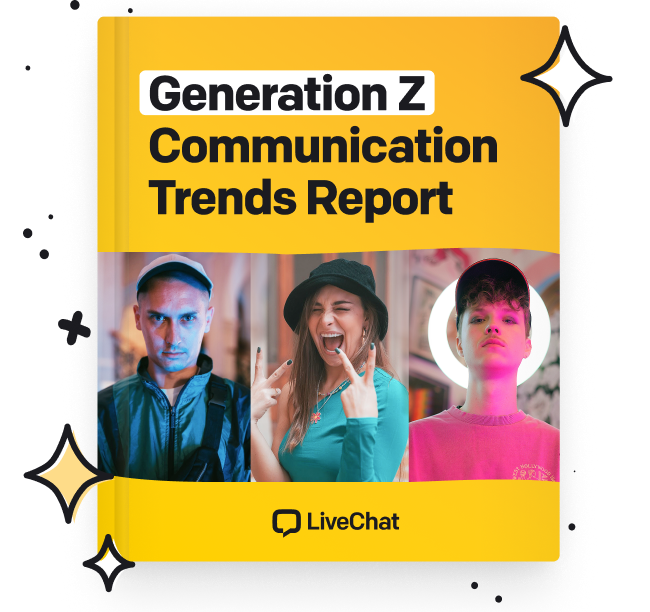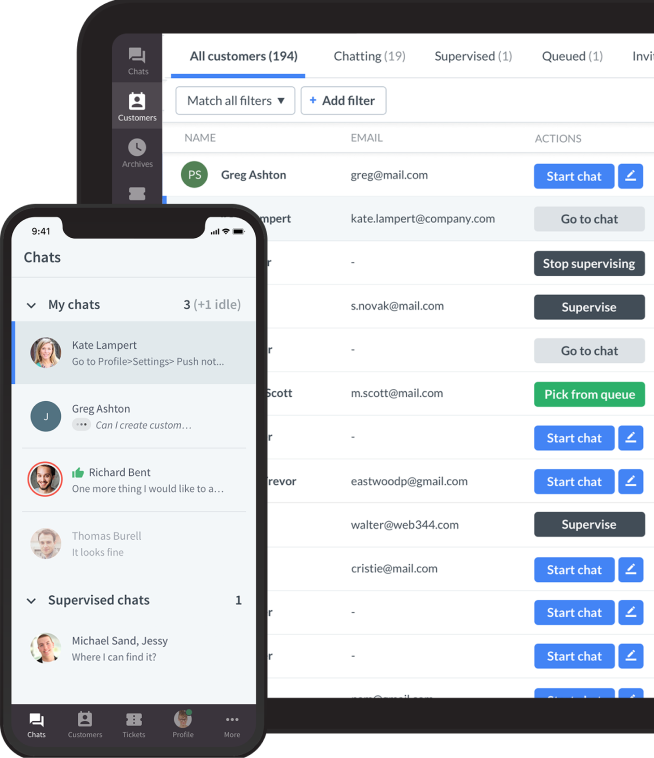Showing top 0 results 0 results found
Showing top 0 results 0 results found

You, as a customer, expect instant answers. You don’t want to wait in a phone queue, fill out a ticket, or get passed from one agent to another. You just wish for fast, accurate help right when you need it. And you're not alone.
A recent CX Trends Report found that 70% of customers expect conversational experiences, and over half are comfortable with AI handling essential support. These expectations have pushed businesses to rethink their service strategies as AI has moved from a nice-to-have to a must-have.
AI customer service agents offer precisely what modern consumers want: fast, 24/7, personalized support without the wait. They’re available across multiple channels, speak your language (literally), and remember past conversations for a smoother experience.

But behind the scenes, there’s more to AI agents than just chat — how they differ when to use them and what tool makes them work smarter, not harder. This article will guide you through the role of AI agents, where they fit in, and how they’re transforming support into something faster, more intelligent, and more personal.
What is an AI customer service agent?
An AI customer service agent is an intelligent, autonomous system that can understand, interpret, and respond to customer inquiries in real time. These agents are built on advanced technologies like natural language processing (NLP), machine learning (ML), and contextual data analysis. These allow them to grasp customer intent, generate relevant, accurate responses, and even perform actions like booking appointments or tracking orders — all without human intervention.
What sets an actual AI agent apart is its ability to learn from each interaction, become more accurate over time, and handle a wide range of customer needs — whether answering simple FAQs or guiding users through complex workflows. They’re especially effective at managing repetitive tasks that would otherwise slow down human agents, such as password resets, order status checks, or billing questions.
By automating these interactions, AI agents help businesses meet rising customer expectations for fast, 24/7 support while also improving customer satisfaction through consistent, accurate, and personalized service. These systems can integrate with CRMs, pull information from knowledge bases, and work across multiple communication channels, making them a key asset in modern customer support.
What are the different types of AI customer service agents?
AI agents don’t come in a one-size-fits-all package. Depending on your business goals, customer needs, and support structure, you might rely on one or more types of AI agents.
Let’s explore the three core categories in depth:
1. Frontline AI agents (fully automated virtual agents)
These are customer-facing bots that interact directly with users, often across multiple touchpoints like your website, mobile app, Messenger, or WhatsApp. They understand user queries, follow structured workflows, and adapt to real-time input as NLP and ML power them.
What they do:
- Greet users and collect key information
- Answer FAQs with contextual accuracy
- Provide instant product or service recommendations
- Guide users through troubleshooting processes
- Process transactions like booking, ordering, or canceling
- Collect leads or feedback with custom forms
Text’s ChatBot is a classic example of a frontline AI agent. It uses a visual drag-and-drop builder, integrates with platforms like Shopify or Stripe, and can be deployed on chat widgets, social platforms, and messaging apps. It handles entire interactions autonomously and offers a smooth handoff to human agents when needed.
Frontline agents help companies scale their support without increasing headcount. They’re ideal for handling high-volume, low-complexity interactions while keeping wait times near zero, which is crucial for ecommerce, SaaS, and logistics businesses.

2. AI assistants for human agents (agent-side copilots)
Unlike chatbots that engage with customers directly, these artificial intelligence tools operate behind the scenes, assisting live agents in real time. They monitor the ongoing conversation and suggest the most relevant responses, resources, or next steps to customer inquiries based on context.
What they do:
- Suggest message drafts based on live customer input
- Pull data from internal sources like help centers, CRMs, and previous chats
- Autofill forms or update customer records
- Summarize conversations or flag important points
- Reduce typing and lookup time so that agents can focus on empathy and problem-solving
LiveChat Copilot is a real-world AI assistant built to support agents during live customer interactions. It offers smart reply suggestions, learns from past conversations, and integrates seamlessly with the LiveChat platform.
AI assistants don’t replace agents but improve them. They’re especially valuable in high-complexity industries like SaaS, finance, or healthcare, where human support is necessary, but speed and accuracy are equally critical.

3. Hybrid AI-human agents (collaborative workflows)
These agents act as the first point of contact, handling and automating routine tasks, then escalating to a human when a situation requires more profound understanding, emotion, or decision-making.
What they do:
- Handle initial greetings and basic customer questions
- Identify the intent and route users to the correct department
- Gather necessary data before handing off to a live agent
- Stay in the loop during live interactions to assist both customer and agent
- Learn from both the customer and agent sides to improve over time
Shopify serves thousands of online businesses that need technical and operational support 24/7. Their hybrid AI model uses a chatbot to handle common customer inquiries like theme installation, billing questions, and plugin recommendations. However, suppose a merchant runs into a more complex issue, like API errors, store outages, or a third-party integration failure. In that case, the bot recognizes its limit and hands it off to a human agent.
Hybrid agents provide the perfect blend of support efficiency and empathy. You get the responsiveness of AI with the trust-building power of a human. This approach is instrumental in customer journeys that start simple but can escalate, like billing issues, complex product returns, or emotional service scenarios.

What are the benefits of AI agents in customer service?
AI customer service agents aren’t just trendy but practical. Businesses of all sizes are seeing measurable improvements across key support metrics by integrating AI into their workflows.
Here’s a closer look at the most significant wins:
| Benefit | What it means | Why it matters |
| Faster response times | AI agents instantly interpret queries and deliver answers with no waiting required. | 90% of customers expect immediate responses to service questions (HubSpot). |
| 24/7 support | AI never sleeps. Instant support is available across time zones and holidays. | Ensures around-the-clock availability, reduces missed opportunities, and improves global reach. |
| Reduced support costs | AI handles thousands of queries simultaneously, lowering the need for large customer service teams. | Automating simple interactions can reduce support costs by up to 30% (Gartner). |
| Accuracy & consistency | AI delivers reliable answers from curated sources with no guesswork or fatigue. | Builds trust with consistent, policy-aligned responses and helps increase customer satisfaction. |
| Agent productivity boost | AI assists humans with smart replies and quick data access, even for routine tasks. | Tools like LiveChat Copilot reduce typing time and improve focus, leading to faster, higher-quality support. |
How do companies use AI customer service agents?
AI agents have evolved far beyond simple Q&A bots. Today, they play critical roles in improving service delivery, optimizing workflows, and personalizing customer experiences — all of which contribute directly to higher customer satisfaction.
Let’s explore some robust, real-world use cases backed by companies already implementing them.
Personalized product recommendations
AI customer service agents can act as digital shopping assistants by accessing customer data in real time, like purchase history, browsing behavior, or even cart activity, to suggest the most relevant products. These recommendations aren't random. They're driven by machine learning models that understand customer preferences and context.
They also increase average order value (AOV), shorten the buyer’s journey, and feel more like concierge-level support than robotic upselling.
H&M, the global fashion retailer, offers style recommendations through a chatbot integrated with its mobile app and Messenger. The chatbot asks users what they’re shopping for ( casual, formal, seasonal, etc.), preferred sizes, and even favorite colors.
The bot then curates an entire outfit and links to each product, creating a dynamic, personalized shopping experience without requiring a single human agent.
AI-powered routing based on customer sentiment
AI agents can assess customer mood and urgency using sentiment analysis, a technique that interprets the emotional tone of text. When a user expresses dissatisfaction, confusion, or urgency, the system can escalate the conversation to a human or route it to a more experienced support tier.
This prevents frustrating situations from escalating. Angry customers don’t want to “press 4 to speak to someone” but want to feel heard and prioritized.
Bank of America’s Erica, their AI virtual assistant, monitors user sentiment in messages related to banking issues. If someone says, “I’ve been overcharged again,” or “This is ridiculous,” Erica flags the given customer conversation and transfers the user to a support team specializing in dispute resolution. Not only does it de-escalate problems quickly, but it also ensures a more sensitive and context-aware human interaction.

Multilingual support for global audiences
AI-powered multilingual support allows you to serve customers across the globe without hiring full multilingual teams. These agents can understand and respond in dozens of languages using advanced translation models, breaking down communication barriers in real time.
This makes customers feel more comfortable and supported when they can speak their native language. This is especially critical in travel, ecommerce, and global SaaS industries.
Airbnb uses AI translation to help guests and hosts communicate, even when they don't speak the same language. The platform ensures that both sides understand each other clearly, whether it's a last-minute change to the check-in or a question about house rules. Their AI system handles over 60 languages and adjusts tone and formality depending on cultural norms.
Post-chat summaries and agent coaching
Once a conversation ends, AI can generate automatic summaries, highlight key takeaways, and identify coaching opportunities for support managers. These summaries can include what the issue was, how it was resolved, and whether any follow-up is required.
They also improve support and service quality, reduce manual documentation, and help train teams by providing relevant examples of what worked and what didn’t.
LiveChat Copilot offers post-interaction summaries that help agents and managers reflect on performance. It flags areas where the tone could’ve been more empathetic or where a quicker resolution path was available. Managers can use these insights in 1:1s or training sessions, helping customer service teams level up without time-consuming chat reviews.

How do LiveChat and Chatbot bring AI to life?
Several customer service platforms today promise artificial intelligence capabilities, but few deliver on that promise with actual efficiency and intuitive integration.
LiveChat and ChatBot are different because they mix advanced virtual conversations with easy-to-use, real-time support for human agents.
Let’s learn more about them.
ChatBot as your frontline for AI-powered customer service
ChatBot is an independent, AI-powered chatbot solution that handles conversations from start to finish. It operates like a fully trained virtual team member, capable of engaging with customers on your website, Facebook Messenger, WhatsApp, and other channels — offering 24/7 support at scale.
ChatBot stands out because of its drag-and-drop builder, which lets teams create rich conversational workflows without writing a single line of code. In a visual interface, you can build smart decision trees, integrate product recommendations, and connect to tools like Shopify, Calendly, or Stripe.
Powered by natural language processing, ChatBot understands customer intent and context, making conversations feel more human and less scripted. When a customer runs into a complex issue or shows signs of frustration, ChatBot doesn’t try to push through. It initiates an intelligent handoff to a human agent in LiveChat, complete with conversation history and context.
Copilot as your AI assistant for innovative customer support
LiveChat Copilot is a built-in AI feature specifically designed to support human agents. It works behind the scenes, analyzing incoming messages and suggesting context-aware, accurate responses in real time. Copilot draws from your company’s knowledge base, previous chat history, help center articles, and other content to instantly offer the most relevant suggestions.
Whether an agent handles one conversation or juggles five, this virtual assistant reduces typing effort, eliminates guesswork, and ensures brand consistency. It even adapts to the tone and topic of the conversation, so an agent helping with a shipping delay gets a different suggestion than one handling a technical bug.
Copilot offers conversation summaries, smart tagging, and post-chat insights for support managers, making team coaching and quality assurance easier.
Enhance customer experience with generative AI
Speed alone isn’t enough as customer expectations grow — context, personalization, empathy, and customer satisfaction matter more than ever. Generative AI can meet this demand when paired with the right human touch.
A practical approach blends both: AI-powered virtual agents tackle high-volume queries efficiently, while intelligent assistance tools give human agents real-time insights and guidance mid-conversation.
The result? A service experience that feels effortless to customers and manageable for teams.
The most brilliant move isn’t simply adopting AI but designing your support around human collaboration that enhances customer experience.
Get a glimpse into the future of business communication with digital natives.
Get the FREE report








Comments